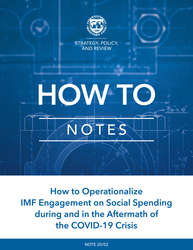
How to Assess Spending Needs of the Sustainable Development Goals: The Third Edition of the IMF SDG Costing Tool
This paper details the 3rd edition of the IMF SDG costing tool, which estimates the additional spending needs to achieve a strong performance in SDGs for human (health and education) and physical capital development (water and sanitation, electricity, and roads).
READ MORE...
Volume/Issue:
Volume 2023
Issue 005
Publication date: December 2023
ISBN: 9798400258787
$5.00
Add to Cart by clicking price of the language and format you'd like to purchase
Available Languages and Formats
| English |
Prices in red indicate formats that are not yet available but are forthcoming.
Topics covered in this book
This title contains information about the following subjects.
Click on a subject if you would like to see other titles with the same subjects.
Economics- Macroeconomics , Public Finance , Economics / General , Demography , SDGs , Sustainable Development Goals , expenditure , spending needs , cost , health , education , water , sanitation , electricity , roads , SDG spending , edition SDG , desk estimate , costing tool , Sustainable Development Goals (SDG) , Health care spending , Infrastructure , Global , Caribbean , Central Asia and the Caucasus , Middle East , North Africa
Also of interest
Summary
This note provides a technical overview and description of the 3rd edition of the IMF SDG costing tool that estimates the additional spending needs to achieve a strong performance in selected SDGs for human capital development (health and education) and physical capital development (infrastructure), in particular, water and sanitation, electricity, and roads. The 3rd edition includes data and methodological updates to, but generally remains faithful to the original approach described in, Gaspar et al. (2019). Globally, additional spending needed to achieve a strong performance in the selected SDGs in 2030 amounts to US$3.0 trillion (3.4 percent of 2030 world GDP). Estimated at 16.1 percent of 2030 LIDC GDP, the average additional SDG cost of this income group is significantly higher than in EMEs, who face additional spending amounting to 4.8 percentage points of their GDP in 2030. In contrast to EMEs and LIDCs, the additional cost for AEs is low, under 0.2 percent of their 2030 GDP.
Copyright © 2010 - 2025
Powered by:
AIDC



